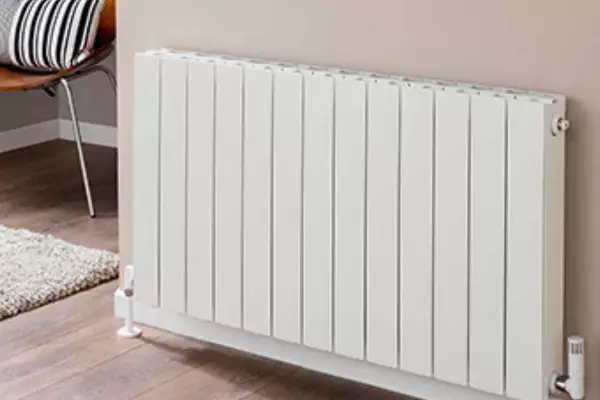If you are getting a new heating system, you should know which one will provide better service. Radiator and baseboard are the most common heating systems in winter or cold regions. But in comparison of radiator vs. baseboard, which one will be a better choice?
Their main difference is the mode of heat transfer means how they deliver the heat. The baseboard uses convection, and the radiator uses radiation to dissipate the heat. There are other sectors to compare like cost, energy efficiency, design and dimensions, flexibility in usage, types, and heating space.
Some similarities will also help you realize how much this system has to offer you. As you can’t get both heating systems, you need to go through edge-to-edge differences between radiator and baseboard.
Contents
An Overview of Radiator
A radiator typically uses hot water, steam, or electricity as its heat source. Cast iron is used to receive the heat and dissipate it to the surroundings. There are also fan-based radiators, oil-based radiators, infrared radiators, etc. A thermostat can control the temperature according to your comfort.
Pros
- Easy to install and operate
- Electric radiators are pretty efficient compared to other models
- Cast iron can easily be modified to fit in the room
- A programmable thermostat is pretty handy
- Longer lifespan
- Can be used to dry the clothes
- Can’t be tipped easily
Cons
- Cast iron radiators are pretty heavy
- Electric radiators will cost extra bills
- Takes time to heat up fully

An Overview of Baseboard
The baseboard heating system primarily uses convection, directly heating the air rather than any object from the surroundings. A small percentage (10%) of baseboard uses radiation as its heat dissipation technique. The baseboards can be water, oil, or cast iron-based.
Pros
- An attached thermostat can easily control the temperature
- Installed is pretty straightforward (you can do it yourself)
- Cheap and available
- Perfect for the house because no need for central air conditioning
- Upfront cost is considerably low
Cons
- Lifespan may reduce due to corrosion
- Quick heat dissipation in hallways or corridors
Dissimilarities Between Baseboard and Radiator
Comparing the differences gives a good view of judgment. Though both heating systems are pretty great to use at home, some crucial facts separate them. And it’s up to you to decide which one you will install after knowing them.
Operation Technique
The baseboard uses convection to distribute the heat. Cold air enters into the mechanism from the bottom of the machine. Then it’s heated, and the hot air goes to the internal mechanism.
Lastly, the aluminum plates help dissipate the heat across the baseboard and through the house. Hot air delivers from the top of the boards.
On the other hand, radiators don’t focus on heating air. Rather than that, it heats the metal or heating objects around it, and then those objects deliver the heat to the surroundings.
That’s why air doesn’t retain the heat as much as the objects.
Cost And Energy Efficiency
The price of the radiators is a bit higher than the baseboard. That’s because of their advanced technology in heat distribution. And the installation is also complicated. So, it would be better to get help from a plumber.
On the other hand, baseboards come at affordable prices. You can easily install it by yourself.
Both of them have an electric variant that is more energy-efficient than their water-based models. But if you come to their efficiency in the same variant, radiators are a step ahead.
As radiators heat a particular object, heat dissipates slowly. You will enjoy the heat much longer in radiators spending the same amount of heat on both.

Flexibility
The heating system on baseboards is divided into multiple zones. It means you can set different temperatures for different rooms. But you have to install a separate thermostat for each room, adding some extra costs.
On the other hand, some panel radiators come with thermostatic heads. It means you can set each panel at different temperatures.
Design
The baseboards don’t have variations in designs. But their installation will reduce your wall area. You will also have to reassemble your furniture while placing copper pipes. That’s because large furniture will disrupt heat dissipation.
Oil radiators don’t consume much space. But if you want to install panel radiators, you have to free wall space around 7 feet. The design of radiators is pretty elegant and can easily fit in your room.
Types
There are two types of radiators: conventional radiators (steam, hot water as heat source) and electric radiators. Based on the types, several models are available in the market.
There are two types of baseboards: convector baseboards and hydronic baseboards (water, oil as a heating medium).
Similarities Between Baseboard and Radiator
Baseboard and radiator have essential functions in common. They both are pretty good choices for central heating systems in your office, home, or other commercial space.
Both of them have multi-zone features that help moderate the heat in different rooms according to your choice. You can also set a thermostat to control the whole heating system without touching it. And the most significant similarity is that they have eco-friendly electric variants.
They are easily customizable and don’t need much effort in maintenance. You can also use both as a combo in commercial buildings because they are compatible with each other and any existing heating system.
Can You Replace Baseboards with Radiators?
Yes, you can replace the baseboards with radiators. In fact, vice versa is also applicable.
But according to the experts, replacing steam radiators with steam baseboards won’t be much cost-effective. Thus, you can shift baseboards to radiators, especially on electric models.
Though you will have some additional bills, electric radiators will be energy and cost-efficient.

Which One Is Preferable to You?
Confusing, isn’t it? Both heating systems provide such great features that choosing one is tricky.
If you don’t want to spend much on your central heating system, you can get a baseboard for this winter. That’s because the baseboards can satisfy you at their best price.
But if you want a more elegant and advanced heating system, a radiator is the best choice. On top of that, it has a lower heat dissipation rate. It means you enjoy a warm environment much longer. Also, the electric baseboards will cost you extras compared to electric radiators.
A Short Comparison Table
Too many descriptions!? Then take a glance at the short comparison table between radiator and baseboard to get an overall idea!
| Topics | Radiator | Baseboard |
| Technique | Radiations | Convection |
| Heating object | No heating objects | Metals, water, oil |
| Cost | Relatively high | Cheap compared to radiators |
| Efficiency | Higher efficiency | Lower efficiency |
| Flexibility | Better flexibility | Flexibility comes with additional costs |
| Heat dissipation | The dissipation rate is low | The dissipation rate is higher |
| Variation in designs | Several elegant models are available | Simple design with fewer variations |
| Types | Conventional and electric | Convector and hydronic |
Final Words
A central heating system is a must, especially when it’s winter, or you live in a cold region where most of the time feels like winter.
Hopefully, our comparison passage of the radiator vs. baseboard has succeeded in clarifying your confusion. You can now choose a better heating system based on your expectations and requirements. We recommend getting the electric variant as it’s eco-friendly. Stay warm in this freezing winter!
